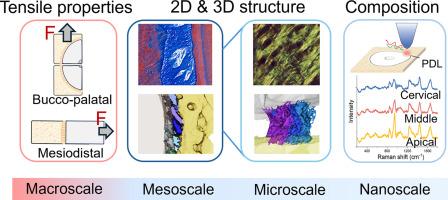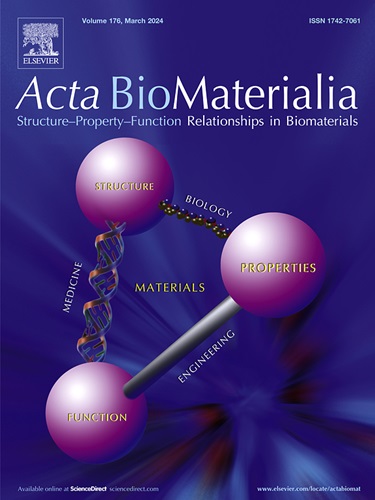了解人类牙周韧带胶原纤维的层次结构:生物力学特征的含义。
IF 9.4
1区 医学
Q1 ENGINEERING, BIOMEDICAL
引用次数: 0
摘要
牙周韧带(PDL)是一种独特的纤维结缔组织,可调节牙周平衡机制。其生物力学特性主要体现在分层且不均匀的胶原蛋白网络中。本研究旨在研究 PDL 中不同尺度胶原纤维的特定区域结构和组成,并探讨它们与分口设计中机械性能的关系。新鲜人类尸体上颌前牙横向 PDL 标本被分为颈部、中部和根尖组。这些标本通过马森三色染色、扫描电子显微镜、皮罗西里红(PSR)染色、三维(3D)重建、拉曼光谱和单轴拉伸试验进行分析。通过统计分析,比较了各组之间的结构、成分和拉伸性能。值得注意的是,与其他两个横切面相比,中间的 PDL 样品表现出更高的抗拉强度和更高的纤维面积分数。尽管矿物质与基质比更高,胶原二级结构也不同,但顶端 PDL 的抗拉强度相对较弱,这可能与其发现的较稀疏的胶原纤维面积分数有关。颈部区域的胶原纤维面积分数较低,抗拉强度也较弱。三维重建胶原网络模型和 PSR 染色显示了纤维间的相互作用和微孔。微尺度孔隙率和胶原二级结构的变化,尤其是顶端区域的变化,表明存在适应机制以适应压缩力并保持功能完整性。样品在不同受力方向的拉伸特性差异表明,纤维取向和牙根水平对组织力学有重大影响。重要意义本研究为人类牙周韧带(PDL)的生物力学和结构特性提供了重要的见解,尤其是对探索不足的前牙。通过扫描电子显微镜、组织学染色、三维重建、拉曼光谱和拉伸测试等先进技术,我们揭示了牙周韧带胶原组织、成分和生物力学特性的显著区域差异。我们的研究结果弥补了有关 PDL 材料力学的重要知识空白,为未来牙周组织工程和生物仿生材料的开发提供了基础性认识。这种多尺度分析强调了中尺度结构特征和纳米级分子结构在维持 PDL 机械完整性方面的重要性。本文章由计算机程序翻译,如有差异,请以英文原文为准。

Understanding the hierarchical structure of collagen fibers of the human periodontal ligament: Implications for biomechanical characteristics
The periodontal ligament (PDL) is a unique fibrous connective tissue that regulates periodontal homeostasis mechanisms. Its biomechanical properties primarily reside in the hierarchical and non-uniform collagenous network. This study aimed to investigate the region-specific structure and composition of collagen fibers in the PDL at various scales and to explore their relationship with mechanical properties in a split-mouth design. Fresh human cadaver transverse PDL specimens of maxillary anterior teeth were categorized into cervical, middle, and apical groups. These specimens were analyzed via Masson’s trichrome staining, scanning electron microscopy, picrosirius red (PSR) staining, three-dimensional (3D) reconstruction, Raman spectroscopy, and uniaxial tensile test. Statistical analyses were performed to compare the structural, compositional, and tensile properties among the groups. Notably, the middle PDL samples exhibited superior tensile strength and higher fiber area fraction than the other two transverse sections. Despite a higher mineral-to-matrix ratio and a different collagen secondary structure, the apical PDL demonstrated a relatively weaker tensile strength, possibly associated with its discovered sparser collagen fiber areal fraction. The cervical region, characterized by a mediocre fiber areal fraction, displayed diminished tensile strength. The 3D reconstructed collagenous network model and PSR staining exposed the fiber interaction and the micropores. Microscale porosity and variations in collagen secondary structure, particularly in the apical region, suggest adaptive mechanisms for accommodating compressive forces and maintaining functional integrity. Variance in the tensile properties of samples in different force directions indicated the significant influence of fiber orientation and root level on tissue mechanics.
Statement of significance
This study provides critical insights into the biomechanical and structural properties of the human periodontal ligament (PDL), particularly focusing on the underexplored anterior teeth. Through advanced techniques like SEM, histological staining, 3D reconstruction, Raman spectroscopy, and tensile testing, we reveal significant regional variations in PDL collagen organization, composition, and biomechanical properties. Our findings address a crucial knowledge gap concerning the material mechanics of the PDL, offering a foundational understanding for future periodontal tissue engineering and biomimetic material development. This multi-scale analysis underscores the importance of both mesoscale structural characteristics and nanoscale molecular structures in maintaining PDL mechanical integrity.
求助全文
通过发布文献求助,成功后即可免费获取论文全文。
去求助
来源期刊

Acta Biomaterialia
工程技术-材料科学:生物材料
CiteScore
16.80
自引率
3.10%
发文量
776
审稿时长
30 days
期刊介绍:
Acta Biomaterialia is a monthly peer-reviewed scientific journal published by Elsevier. The journal was established in January 2005. The editor-in-chief is W.R. Wagner (University of Pittsburgh). The journal covers research in biomaterials science, including the interrelationship of biomaterial structure and function from macroscale to nanoscale. Topical coverage includes biomedical and biocompatible materials.
 求助内容:
求助内容: 应助结果提醒方式:
应助结果提醒方式:


